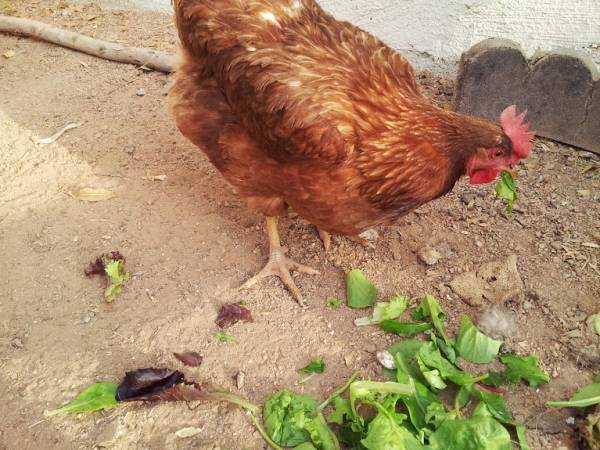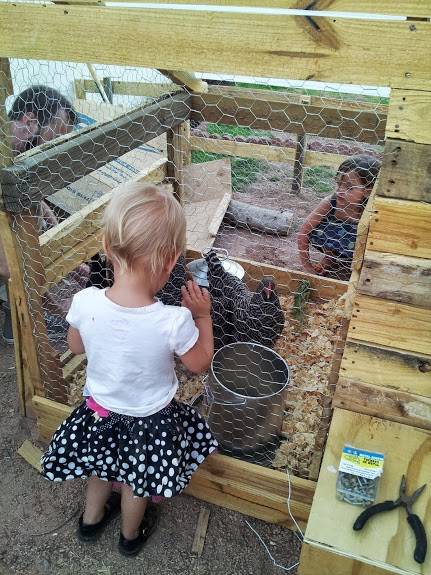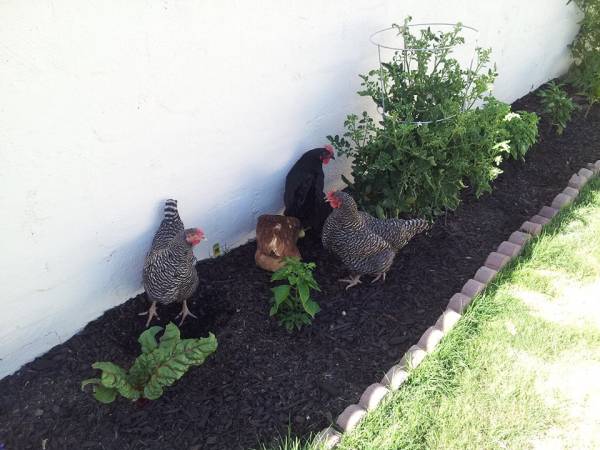It’s 2:00 and you have a hankering for some protein. You grill up some chicken breast and have a nice mid-day snack. Ah, delicious protein. Then you get to thinking…do you really know where that chicken came from? Was it a happy chicken? Did it have access to open air? Did it have a name? Panic strikes. Should you really be eating this chicken?
How do you avoid this embarrassing situation? Raise your food yourself. In our desire to get in touch with our food without losing our sanity like this unfortunate couple, when my husband and I moved to a new house a year ago we started to strategize about the most cost-efficient and sustainable ways we could do so. Since we don’t have a big backyard, the most obvious choice was to buy chickens.
Like many active people out there, our family eats a lot of eggs. We go through at least two dozen a week, if not three or four. That’s fine if you don’t care about the quality of your eggs. You can get several dozen eggs at Walmart for about six bucks where we live. And that’s exactly what we did, until a few years ago when we started learning about where those eggs come from.
Rather than blabbering on and on about why we developed an aversion to conventional eggs, here’s a short video of one minute in the life of your typical conventionally raised hen:
Without knowing the way chickens normally live, you might not be that disturbed by this video. Sure, she looks a little cramped and uncomfortable, but you have to feed the world, right? And who knows, maybe this is just one of the particularly bad minutes in the day and the rest of the day the hen is happy. To me, there’s one telltale sign that this is the way this hen must spend the majority of her time. Have a look at poor battery hen’s neck:
Now compare that to this hen’s neck (I’m not an expert, but I think they might even be the same breed):

The second neck belongs to our Cinnamon Queen, Canela. Notice: you can’t see it. All you see is magnificent plumage. A chicken’s feathers speak volumes about its health and living conditions. Chicken #1 has a feather deficiency, and that doesn’t stop with plumage. According to a 2007 study, this is how eggs from free range chickens compare to conventionally raised eggs:
- ⅓ less cholesterol
- ¼ less saturated fat
- ⅔ more vitamin A
- 2 times more omega-3 fatty acids
- 3 times more vitamin E
- 7 times more beta-carotene
Learning these and other things about the current state of factory chickens made us want to take action. For a long time, our family’s solution was to buy local eggs at the farmer’s market. However, we also happen to be on a tight grocery budget, and $6 a dozen is a little steep when we have to buy two or three dozen eggs each week. We decided we were just going to buy our own chickens and raise our own protein in the meantime.
And so, a few months ago, my husband made me a chicken coop for a birthday present and we brought our hens home. I was a little worried they would be too much work and take too much time, but think I will always want to keep chickens. Not only are they fun and pretty low-maintenance, but we know exactly what our hens eat, how much open air they get every day, and what kind of conditions they live in. However, there have been challenges along the way. If you’re considering keeping chickens, here is some advice for getting started from someone who is also a beginner:
1. Buy Breeds That Are a Good Fit For Your Area

Just like gardening, one of the most important first steps in raising chickens is researching the breeds that will work best for you and your needs. Some chicken breeds are broodier than others. Other breeds might be intended for meat and aren’t the best layers. Keep in mind you don’t have to only raise one breed, so you can experiment with a few different kinds of chickens and see if there is any noticeable difference between them.
2. Location, Location, Location
Plan the location of your coop carefully. Consider the elements – does this area of the yard get a lot of intense sun? If so, you will need to provide a source of shade. You will also want to research the zoning requirements in your area. Some zoning laws require chickens to be a certain number of feet from the nearest dwelling, so be sure you have enough room for a coop and a run where your chickens can run free and roll around in the dirt during the day.
3. Don’t Forget the Fruits and Veggies
We notice a dramatic difference in our hens’ laying frequency when they have a lot of fresh greens. Since our coop is on dirt, our hens don’t have access to grass unless we let them out of the run, so we make sure to give them lots of leafy greens and chopped grass several times a day. One of the great things about chickens is they go a long way in minimizing kitchen waste. You can give them pretty much any fruit or vegetable you would eat. Our hens are big fans of watermelon, strawberries, and bell peppers.
4. Seek Out Local Resources
On day three of our recent two-week vacation, the guy who was caring for our chickens texted us to tell us that two of our hens hadn’t made it through the hottest day of the summer (119 degrees). It was discouraging and we felt like bad chicken parents. However, it was reassuring to see a Facebook post later that day by a local permaculture group saying that they had had multiple emails from other people in Phoenix saying their chicken and quail were dropping like flies. The organization also posted a video of a few things you can do to keep your chickens cool in intense heat. Find a local resource or group of people who can provide advice and recommendations that are specific to issues in your particular area.
5. Protect Your Plants
If you happen to also be a gardener and plan to allow your chickens to roam free, protect your plants because the hens will eat them. A few days after we got our hens, I decided to just let them roam around on the grassy part of our yard for awhile. After about 5 minutes I came out to find this:

They had taken some large bites out of my kale, eaten about 20 cucumbers, destroyed my beautiful heirloom tomatoes (which were just on the verge of being ripe), demolished my bell pepper plants, and had a scratching fit right over my oregano plant. If you plan to let your chickens roam and have gardens that are at all accessible, use netting to cover your plants.
The biggest lesson I think I’ve learned while raising chickens is that if you want real food, you have to deal with real life. I’m not going to sit here and tell you that cleaning a chicken coop is pleasant or that your chickens will never get sick. It’s not, and they will, and that’s all a part of it. I read this article about the record number of chickens that are being abandoned when their owners realize that keeping chickens isn’t always romantic and nostalgic. If you’re not prepared to deal with smells, dirt, work, and the prospect that your chickens might get sick or even die, you might want to hold off on the backyard homestead stuff.
If you are prepared to deal with challenges and also attracted to the idea of raising your own food, don’t let those factors intimidate you. Not only are chickens nice for practical reasons, but they’re also great pets. And if you do decide to use your chickens for meat, you will be able to rest assured that they lived happy lives and had beautiful necks.






